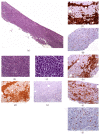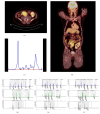Late Onset Graft Plasmacytoma-Like PTLD Presenting as Acute Hyperglycemia in a Kidney-Pancreas Transplant Recipient
- PMID: 31236295
- PMCID: PMC6545763
- DOI: 10.1155/2019/2818074
Late Onset Graft Plasmacytoma-Like PTLD Presenting as Acute Hyperglycemia in a Kidney-Pancreas Transplant Recipient
Abstract
Allograft infiltration has been described in up to 20% of all patients with posttransplant lymphoproliferative disorder (PTLD), most representing EBV-positive B-cell lymphomas. Plasma cells are often observed in humoral rejection biopsies, but graft infiltration by plasmacytoma-like PTLD is rare. We report the case of a 54-year-old simultaneous pancreas-kidney transplant recipient (immunosuppression: OKT3, methylprednisolone, cyclosporine, and azathioprine), diagnosed with an IgG-kappa monoclonal gammopathy of undetermined significance eighteen years after transplant. Nine months later, pancreas allograft biopsy performed due to new-onset hyperglycemia (HgA1C 8.6%, C-peptide 6.15ng/mL and anti-GAD 0.9UI/mL) revealed a monotypic plasma cell infiltrate, CD19, CD79a, CD138 positive, with IgG-kappa light chain restriction, and EBV negative. PET-scan FDG uptake was limited to pancreas allograft. Tumor origin could not be established (using DNA microsatellite analysis). Despite treatment with bortezomib and dexamethasone, patient eventually died one month later. This is the first report of a late onset extramedullary plasmacytoma involving a pancreas allograft.
Figures


Similar articles
-
Primary cutaneous giant cell plasmacytoma in an organ transplant recipient: a rare presentation of a posttransplant lymphoproliferative disorder.Am J Dermatopathol. 2010 Jul;32(5):479-85. doi: 10.1097/DAD.0b013e3181c2c0b5. Am J Dermatopathol. 2010. PMID: 20414094
-
Posttransplant lymphoproliferative disorder in liver allograft biopsies: a comparison of three methods for the demonstration of Epstein-Barr virus.Hum Pathol. 1997 May;28(5):533-9. doi: 10.1016/s0046-8177(97)90074-5. Hum Pathol. 1997. PMID: 9158700
-
Posttransplant lymphoproliferative disorder in pediatric renal transplantation.Pediatr Nephrol. 1999 Nov;13(9):748-54. doi: 10.1007/s004670050692. Pediatr Nephrol. 1999. PMID: 10603113
-
A rare case of primary cutaneous plasmacytoma-like lymphoproliferative disorder following renal transplantation.J Cutan Pathol. 2012 Jul;39(7):685-9. doi: 10.1111/j.1600-0560.2012.01919.x. Epub 2012 May 11. J Cutan Pathol. 2012. PMID: 22574640 Review.
-
Clinicopathologic characteristics of post-transplant lymphoproliferative disorders.Recent Results Cancer Res. 2002;159:9-18. doi: 10.1007/978-3-642-56352-2_2. Recent Results Cancer Res. 2002. PMID: 11785849 Review.
References
-
- Caillard S., Lamy F. X., Quelen C., et al. Epidemiology of posttransplant lymphoproliferative disorders in adult kidney and kidney pancreas recipients: report of the French registry and analysis of subgroups of lymphomas. American Journal of Transplantation. 2012;12(3):682–693. doi: 10.1111/j.1600-6143.2011.03896.x. - DOI - PubMed
-
- Caillard S., Lelong C., Pessione F., Moulin B. Post-transplant lymphoproliferative disorders occurring after renal transplantation in adults: report of 230 cases from the French registry. American Journal of Transplantation. 2006;6(11):2735–2742. doi: 10.1111/j.1600-6143.2006.01540.x. - DOI - PubMed
Publication types
LinkOut - more resources
Full Text Sources
Miscellaneous

